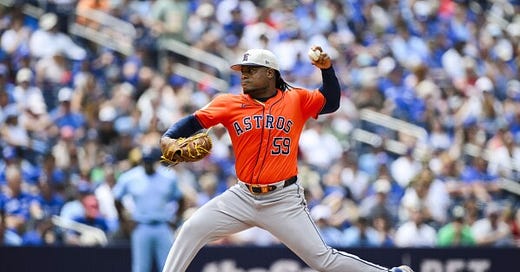Framber Valdez's Strikeout Rate is Sharply Down This Season
And it's a big reason why his ERA is up and he is no longer pitching at an ace level.
On Thursday, Framber Valdez looked like the 2022 version of Framber Valdez. Valdez gave up more base runners than ideal, allowing 9 hits and 2 walks. But he allowed only one extra base hit and limited damage by inducing four double plays—three on grounders—and a soft grounder just in front of the plate in his highest leverage at bat—with runners on the corners with one out in a tie game in the bottom of the sixth.
Notably, Valdez had only 4 strikeouts among the 25 batters he faced. That’s a 16% strikeout rate.
That strikeout rate in yesterday’s game is not an anomaly for Valdez in 2024. This season, Valdez has struck out only 19.0% of the batters that he has faced. As the chart below shows you, that’s not only below the major league average strikeout rate (22.2%), but also the lowest of Valdez’s career.
Valdez’s strikeout rate did not suddenly decline on Opening Day of the 2024 season. Instead, the sudden declined happened in the middle of the 2023 season. The chart below shows Valdez’s strikeout rate using a 15 game rolling average. Valdez’s K% increased sharply in the middle of the 2022 season and kept increasing through the All-Star break in 2023. It then declined precipitously and immediately, held steady for a while, before declining again across the last two months of this season.
From a pitchers; standpoint, strikeouts are a good thing. They are guaranteed outs, while batted balls are not. More outs of course means fewer runs.
Unsurprisingly, Valdez’s decline in strikeout rate has also led to an increase in his ERA. In the chart below, you can see that Valdez’s ERA started spiking in the middle of the 2023—i.e. exactly when his strikeout rate declined.
The good news is that Valdez has stanched the bleeding in his ERA and it is no longer increasing. The bad news is that his ERA this season is 3.84, good for only 49th best among all qualified major league starting pitchers.
Why Has Valdez’s Strikeout Rate Dropped So Sharply? It’s Unclear
That Valdez’s strikeout rate has dropped is clear from the numbers. But the harder thing to figure out is why it has declined. There are not big jumps in the underlying data that might tell us what has gone so wrong.
The chart below shows Valdez’s ability to get batters to chase pitches outside of the strike zone (Fangraphs calls this O-Swing%—O is for “outside the strike zone”) and the ability of batters to make contact on Valdez’s pitches that are outside the zone (O-Contact%).
You can see that Valdez’s O-Swing% has remained relatively steady from 2022 to 2024. It has declined some this season, but was actually increasing across the second half of the 2023 season.
For the O-Contact% measure, higher values are bad for pitchers. This measures contact and pitchers want to miss bats. Batters were getting less contact against Valdez in the second half of 2022 and more contact since early in 2023. But that increase is pretty steady, and does not have have a big jump in the middle of 2023. Nor is the contact rate as high as it was for Valdez back in 2021.
You see something similar in Valdez’s swinging strike rate (SwStr%). There is an increase through the 2022 season and a clear decline early in 2023. But this rate has been steady ever since then, even as his strikeout rate has declined.

Valdez’s Ground Ball Ability Reduces the Harm of Hard Contact
Yet while Valdez’s strikeout rate has gone down since his peak season in 2022, other parts of his game remain the same. Valdez continues his unique combination of giving up high rates of hard hit balls (2nd percentile according to Statcast) but a low rate of barreled balls (87th percentile).
That is due to Valdez’s ability to induce ground balls—his 62.5% ground ball rate is at the 98th percentile. Ground balls can find their way through the infielders, but hard hit ground balls do less damage than hard hit fly balls—they can never be a home run.
We saw this yesterday, as the Blue Jays hit 11 balls with exit velocities of more than 95 miles per hour and six of more than 100 MPH in the 19 batted balls they hit off of Valdez. Four of those over 100 MPH exit velocities came in the first six hitters of the game, producing three Blue Jay runs.
But Valdez was able to limit the damage in the first inning thanks to Ernie Clement lining into a double play. Valdez then shut out the Blue Jays for the rest of his six innings, thanks in large part to his ability to induce grounders. The Blue Jays hit into three more double plays against Valdez.
Overall, the Valdez start was effective enough. He gave up three runs over six innings despite his low walk rate. The Astros offense came through with five runs and the bullpen backed up Valdez with three shutout innings.
In 2022, Valdez was an ace. His 2.82 ERA was 11th best among qualified major league starters and his 194 strikeouts were 13th best. In the playoffs that year, Valdez was lights out, with a 1.44 ERA and 33 strikeouts and over 25 innings (4 starts). I would have voted for him as the MVP of the World Series.
But since the middle of last season, Valdez has declined to an above average major league pitcher. He is still helpful to the Astros efforts to get to the playoffs this year, especially since he seems a particularly durable pitcher. But until he gets his strikeout rate back up, he won’t be the ace we saw in 2022.








